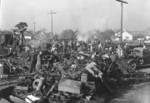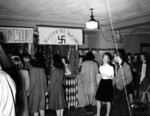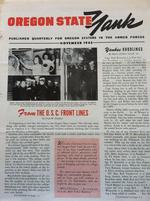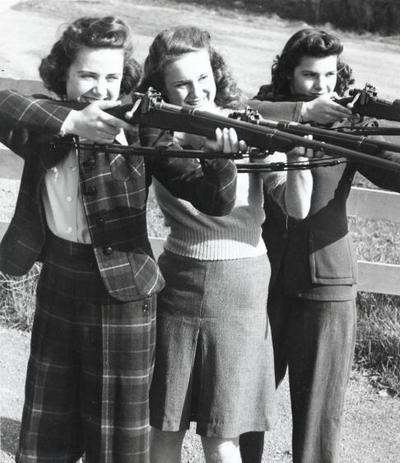
Three OSC coed females with Army rifles, 1941. The rifles are US Military M-1903 Springfield Bolt Action, with special after market adjustable peep sights, most likely used for the precision rifle team. Photograph appears to be staged for publicity shot, possibly in the Oregon Stater or Beaver Yearbook.
EARLY YEARS OF THE WAR:
As the 1941 Pacific Coast Conference's champion the OSC football team upset Duke 20-16 in the Rose Bowl. [1] Fearing an attack if played on the West Coast due to the recent entry of the US into the war with the Japanese attack on Pearl Harbor, the game was played on January 1, 1942, in Durham, North Carolina. It has been Oregon State's only Rose Bowl victory to date. However, as the Yank reports later in May, 1944, there was confusion as to the actual outcome of the game. OSC, in both the Football Guide and the World Almanac, is reported to have lost the game.[2] This would the last game for the football team until the end of the war. In August 1943, the US War Department declared that all military trainees on college campuses around the country could not compete in athletics.[3]
However, the war of course affected Oregon State students and alumni who left to fight in the war. Although an "adequate account of the achievements of the many thousands of Oregon State men and woman in World War II is impossible. They [won] honor in every zone of occupation or combat. They served in North Africa, the Aleutians, Belgium, the bulge, Burma, Guam, India, Italy; at Bougainville, Corregidor, Iwo Jima, Leyte, Luzon, in the Mariana's, the Marshall's, New Guinea, Normandy, the Solomon's; at Mindanao, Okinawa, Saipan, St. Lo, Shimusha, Tarawa."[4]
“THE OREGON STATE YANK:”
A small paper printed by two women in order to facilitate communication of Oregon State happenings to those in the military. They covered sports and social happenings, “Campus Observations, ”and also changes which were occurring on the OSC campus. “The Yank” also chronicled the advancements of OSC soldiers and their news from the front and bases around the world. The newspaper grew in popularity as the war went on and circulation grew as well. It was a free publication, but they of course accepted donations in order to maintain its publication and circulation around the world. Letters the editors received tell of issues being passed around to several people and also include more addresses for servicemen who would enjoy receiving their own copy.[5]
NEARING THE END:
As the war began to draw to a close, President Strand began “collecting and preserving all records having to do with Oregon State Colleges part in the present war."[6] He desired:
1) to determine what materials are available and arrange to have them accessible to interested users now and in the future.
2) to collect and deposit accessible additional materials.
3) to arrange for the preparation of reports and memoranda to be added to the collections.
4) to prepare a summary or guide to collected materials setting forth descriptions, place deposited, and conditions of use.
This desire to collect war related stories and information was part of a larger call for collection in Oregon and the nation as a whole. After the call went out, a wide variety of responses to President Strand’s letter were collected from nearly every department on campus at the time. Collected documents include information about faculty involvement, both on campus/locally and abroad, and also different programs and classes which went into effect due to the war. In the spring of 1943, for example, the Zoology Department offered “Physiology for wartime needs.”[7]
AFTER THE WAR:
As the war began to wind down, “The Yank” detailed what lay ahead for OSC and campus life. The student population would be quickly changing as more and more returning soldiers returned to the campus with support of the GI Bill.[8] Women would no longer be the dominant sex on campus, but enrollment was predicted to increase across the board. In order to help with this growth in population, President Strand proposed to use the money from the State’s 10 Building Program to build men’s and women’s dorms, and a new football field further off campus.[9] Also, living quarters would also be readjusted as fewer soldiers needed to be housed on campus, and Waldo Hall would again be home to women. For the returning soldiers, there would also be a new set of courses open to them, some for those seeking a degree and others merely for continuation of education.[10]
After the war ended, OSC continued to support the US military and established the Air Force ROTC on July 1, 1949. [11] And today, OSU remains one of only thirty-three universities in the US which offer officer training in all the major branches of the military.
[2] Oregon State Yank, “Contrary to Records, We Won,” pg. 7, May, 1944, PUB 10-15c, OSU SCARC.
[3] Oregon State Yank, “No Football at OSC this Year,” pg. 3, November, 1943, PUB 10-15c, OSU SCARC.
[4] MSC OSC History of World War II Project Records: Correspondence, OSC Participation Harriet Moore Research, 1943-1947, OSU SCARC.
[5] “Oregon State Yank Collection, 1942-1945,” MSS Yank, OSU SCARC.
[6] “The Committee to Collect and preserve Records Pertaining to OSC's Part in World War II” (11-16-1944, MSC OSC History of World War II Project Records: Correspondence, 1944-1946), OSU SCARC.
[7] “Summary of war activity: department of zoology,” November 14, 1945, MSC OSC History of World War II Project Records: OSC Participation, Harriet Moore research, 1944-1946, OSU SCARC.
[8] Oregon State Yank, pg. 7, August, 1944, PUB 10-15c, OSU SCARC.
[9] Oregon State Yank, pg. 1, November, 1944, PUB 10-15c, OSU SCARC.
[10] Ibid, pg.13.

Rose Bowl program cover. Because of WWII and the fear of an attack on the west coast, the Rose Bowl was played in Durham, North Carolina.
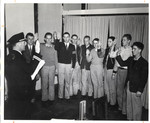
US Navy officer swearing in new recruits, 1942. The Navy V-12 and Army ASTP programs were located on OSC campus during WWII. This photo originally appeared on pg. 235 of the 1943 OSC Beaver Yearbook.
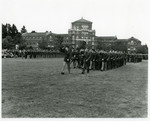
Military review of cadets by then Governor Sprague, possible date, May 1941. Military parade of cadets marching in formation past reviewing stand with dignitaries. Weatherford Hall in background of parade field has scaffolding on center tower as seen in other photographs of this vintage.
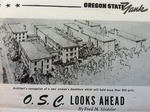
As the war neared its end, campus began to look to life after the war and how the predicted influx of students would be accomodated.

